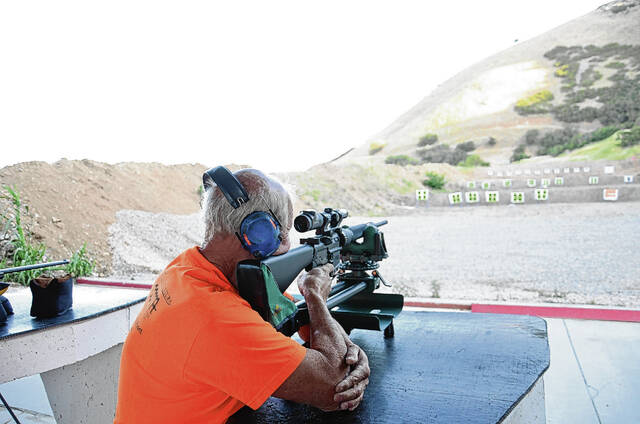The Federal Aid in Wildlife Restoration Act, known as the “Pittman-Robertson Act,” was passed in 1937 to provide federal funds for state management of wildlife. The money is collected from an 11 percent excise tax on sporting arms, ammunition, bows, arrows, and their parts and accessories. Meaning, every time someone buys guns, bullets or archery equipment, they are contributing to the pool of money distributed across the country to take care of wildlife and wild places.
According to the U.S. Fish and Wildlife Service website, the funds are appropriated to the Secretary of the Interior and apportioned to states on a formula basis for paying up to 75 percent of the cost approved projects. Project activities include acquisition and improvement of wildlife habitat, introduction of wildlife into suitable habitat, research into wildlife problems, surveys and inventories of wildlife problems, acquisition and development of access facilities for public use and hunter education programs, including construction and operation of public target ranges.
When I was young, 13 or so, Dave Miller, the farmer whose land I hunted, called me the “aerator.” He said with as many arrows as I stuck in the ground missing deer, he didn’t need to waste his time aerating his fields. I was taking care of it for him. It’s wild how 30 years later, I can still vividly see this beautiful buck walking towards me along a trail carved through shin-deep snow. At 20 yards, I missed him by at least two feet. The nickname was well earned.
My early accuracy with firearms wasn’t much better. When I was growing up in Indiana, you could only hunt with muzzleloaders and shotguns. This is before the more accurate inline smokeploles came around and when only the wealthy could afford rifled slug barrels. I threw more knuckle balls at deer I missed than I care to admit.
Over time, I’ve become a much more accurate marksman with both gun and bow. Learning how to control my nerves was a big part of this improvement, though I still struggle with knees knocking as heavy horned bucks approach. The by far biggest reason for my improvement was practice. I began to shoot a lot. While I still consider myself a hunter who shoots instead of a shooter who hunts, I do send a lot of ammunition down range.
These days, it’s been much harder to let loose of the ammo I have on hand because replacing it has at times been impossible. And, I don’t believe the current outlook of purchasing ammunition is very bright, with all the chaos in the world. So if you want to continue shooting, like I do, but fear letting loose of too many rounds, then you have to practice smarter.
It’s not too often anymore that I come across a tool that I feel really improves my ability to shoot or hunt. Over the past couple of decades, I’ve been introduced to so many trends from scent control to stabilizers to lasers that it seems like the industry marketing minds want you to believe it was nearly impossible for the early pioneers to kill anything without today’s technology. I tend to shy away from technology when it comes to hunting and shooting, but at the Professional Outdoor Media Association (POMA) conference last summer, I was introduced to Mantis.
The POMA conference always includes Shooting Day at the Range, where numerous manufactures are on hand to let us outdoor communicators test out their equipment. It’s always a blast, pun intended. When I made it to the Mantis booth and saw everyone huddled around a smart phone, I thought I’d just walk on by, but curiosity kills the cat. So I checked it out. I’m glad I did, because their tools for improving shooting accuracy are pretty cool.
In a nutshell, you attach a sensor to whatever firearm or bow you are shooting and download an app to your phone. When you shoot, the sensor collects all the data on your movement and sends it to the phone. So you can see if you are flinching, dropping your hands, moving one way or another. You can track your progress to see if you are consistently making the same errors, and hopefully, you’ll start to see that you are steadily improving.
A great feature about the system is, you can use it while dry firing your gun. You cannot dry fire bows. You don’t want to dry fire your gun without a dummy cartridge, known as a snap cap. These are very cheap. Buy one for every firearm caliber you want to practice with, then attach your Mantis, and pretend you are firing live ammunition. Through the app, you will see your movement and hopefully build better shooting practices through increased muscle memory.
It works really well on bows and crossbows, too, although you do have to actually shoot arrows or bolts. I have been using it on my traditional bows, which I know, I am using an advanced piece of technology and software on a piece of wood I use to fling sticks. Quite the oxymoron. But it really helps. I can see what my hands and arms are doing when I release the arrow. Because if I’m being honest, when it comes to traditional archery, the aerator is alive and well.
The importance of purchasing ammunition and equipment that funds the Pittman-Robertson Act is huge. And I just gave you a tip that should reduce the amount of ammunition you need to buy. So I’m working counter to my own desire to see the most money as sensibly possible sent to fund conservation. I have contributed a lot over the years and plan to for the rest of my life, but maybe not as much from purchasing ammunition. Just make sure you spend the money you save on ammo to purchase that new rifle you’ve had your eye on.
See you down the trail.
Brandon Butler writes an outdoors column for The Republic. Send comments to [email protected]. For more Driftwood Outdoors, check out the podcast on www.driftwoodoutdoors.com or anywhere podcasts are streamed.





